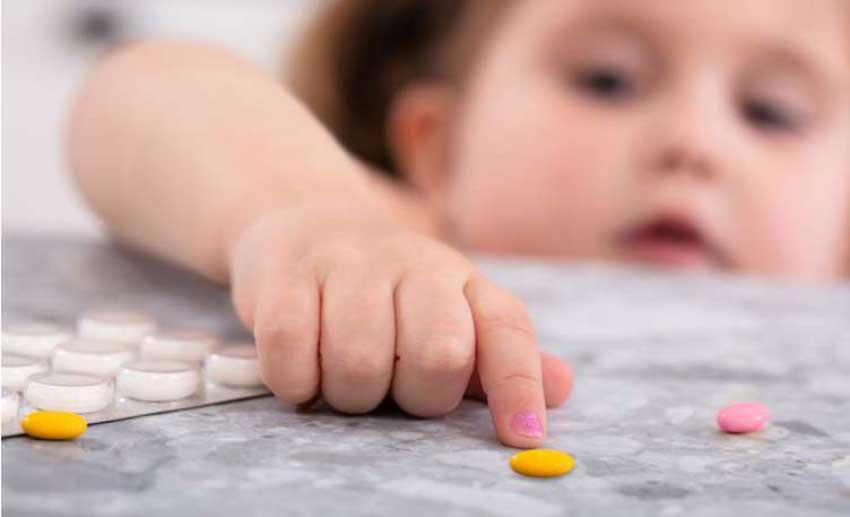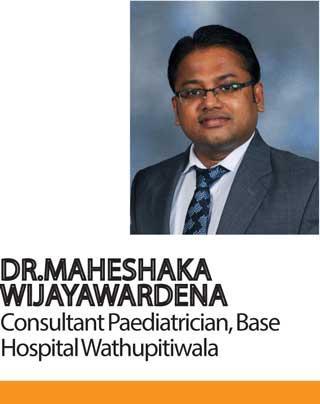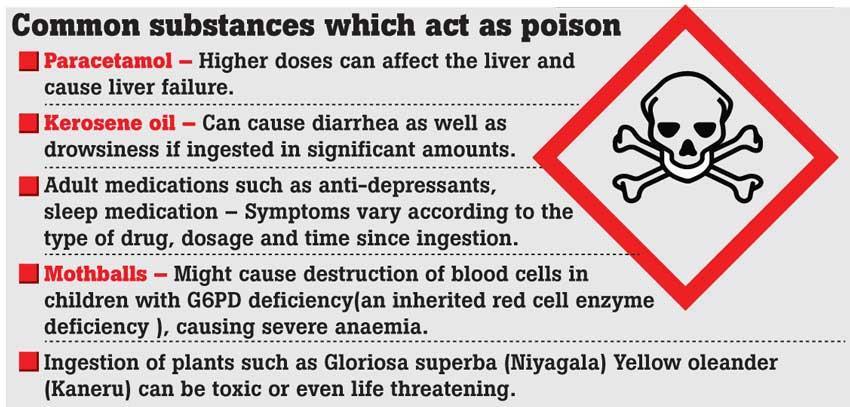04 Jun 2021 - {{hitsCtrl.values.hits}}

 Poisoning is one of the commonest reason for kids to present to emergency department. As anything from ingestion of dishwashing liquid to accidental ingestion of medication can be considered poisoning, this is one topic that the parents need to be informed about. In today’s health capsule we will discuss about poisoning in children, including what should be done following ingestion of a substance and the management of some common substance poisoning. Joining with us today in our discussion is Dr.Maheshaka Wijayawardena, Consultant Paediatrician, Base Hospital Wathupitiwala.
Poisoning is one of the commonest reason for kids to present to emergency department. As anything from ingestion of dishwashing liquid to accidental ingestion of medication can be considered poisoning, this is one topic that the parents need to be informed about. In today’s health capsule we will discuss about poisoning in children, including what should be done following ingestion of a substance and the management of some common substance poisoning. Joining with us today in our discussion is Dr.Maheshaka Wijayawardena, Consultant Paediatrician, Base Hospital Wathupitiwala.
 About poisoning in children
About poisoning in children
There are two common presentations of children who are admitted to ER following poisoning. Commonest is when the adults observe or suspect a child of ingesting a foreign substance, and bring the child. “But, poisoning should also be suspected in children who present to ER with sudden onset of symptoms like seizure or loss of consciousness, children presenting with puzzling symptoms which do not add up and involvement of multiple organs or systems”, explains Dr.Wijayawardena.
Accidental poisoning is commonest in 1-4 years age group. Teenagers who present following poisoning might ingest the substances because of suicidal ideation or might have attempted abuse of recreational drugs.
Common substances which act as poison
Paracetamol is one of the commonest substances to be overdosed. One reason for that is its easy availability at almost any house. Another common cause for paracetamol poisoning is mistaking paracetamol dropper solution; which has a very high concentration of paracetamol per milliliter, for paracetamol syrup, which has a lower concentration of paracetamol. Paracetamol in higher doses can affect the liver and cause liver failure.
Kerosene oil is another product that is commonly ingested by accident. It can cause diarrhea as well as drowsiness if ingested in significant amounts. Other petroleum based products like petrol, diesel and thinner ingestion is also fairly common.
Adult medications are another major cause of poisoning. Anti depressants, sleep medication, blood pressure lowering drugs and diabetes medication are some of the common medication that can be ingested. These children could present following either ingestion of a single drug or a combination of drugs. Symptoms may vary according to the type of drug, dosage and time since ingestion.
Mothballs are another common substance to be ingested accidentally and might cause destruction of blood cells in children with G6PD deficiency(an inherited red cell enzyme deficiency ), causing severe anaemia. Domestic cleaning products like liquid detergents/ bathroom cleaning products are also amongst commonly ingested substances.
In addition, children often present following ingestion of plants. While some plants are quite harmless, parts of certain plants like Gloriosa superba (Niyagala) Yellow oleander (Kaneru) can be toxic or even life threatening.
 First aid at home
First aid at home
Wash the child’s mouth and the face well. Remove any clothes with the substance, and wash the area well with running water, as certain poisons like paraquet and corrosives can cause damage just by skin contact.
DO NOT try to induce vomiting. Vomiting in certain substance poisoning, like kerosene oil can cause more damage and there is a risk of aspiration while inducing vomiting. Administering various home remedies like coconut milk is also highly inadvisable as they may inadvertently cause further harm.
Take the child to the nearest hospital as soon as possible. This is the most crucial part following poisoning, as certain treatments like gastric washout and administration of activated charcoal are only useful in a limited time frame since ingestion of the substance.
Parents should bring the prescription, left over medication/poison or labelled container when they come to the hospital as these will be useful in the next step of management. If the child ingested a part of a plant, bringing along a branch or an identifiable part of the plant would be useful.
Management at the hospital
When a child following suspected poisoning is brought to the hospital, initial stabilization, which include emergency management such as management of seizures securing aiway, etc. would be the first step. This is vital in case the child presents with an altered mental status.
Evaluation and specific management according to the ingested substance would be commenced, next. Vital signs would differ according to the ingested substance. For an example, some substances can cause elevated heart rate while the others cause it to slow down. Some substances like organo phosphates cause constriction of the pupils.
Early managements like gastric washout, administering activated charcoal would be commenced as needed.
Investigations that would be ordered can vary from blood sugar levels to blood electrolyte levels, clotting profiles, blood acidity, liver function tests, kidney function tests, blood paracetamol levels in case of paracetamol poisoning and ECG.
Some substances have antidotes which could be administered according to the child’s status.
While some poisons are removed from the body quite early, others do long term damage, so might need to be followed up.
Teenagers/ children presenting with deliberate substance ingestion may need psychological evaluation and counseling to avoid repeating the incident in the future.
Prevention
Most childhood poisonings are preventable if adequate precautions are taken.
Preventive measures against poisoning are of three-fold. Legislative measures include banning of importing highly toxic chemicals, drugs, and regulating the selling of toxic substances. Product engineering also can help minimize the risks of poisoning through measures like installation of child safety locks to medicine bottles. But the most important and the practical means of preventing poisoning at home is through education of the population.
Parents should be advised regarding preventing domestic poisoning at routine clinics.
Identifying and removing toxic plants from the gardens, storing medication and possible harmful substances under lock and key are some of the measures that can be taken around the home to minimize the risk of poisoning. Buying harmful substances like acids or pesticides in small amounts and discarding any remaining substance immediately after use can also be done. Labeling the containers and not storing them in generic and attractively shaped vessels which might get the child’s attention easily should also be done in case of storing of possibly toxic substances.
In summary, while we cannot make the risk of substance poisoning zero, we can substantially reduce it through caution and correct measures. In case of suspected poisoning, most important step is to get the child to the nearest hospital as soon as possible, concludes the doctor.

Yellow oleander

24 Apr 2024 2 hours ago
24 Apr 2024 2 hours ago
24 Apr 2024 3 hours ago
24 Apr 2024 3 hours ago